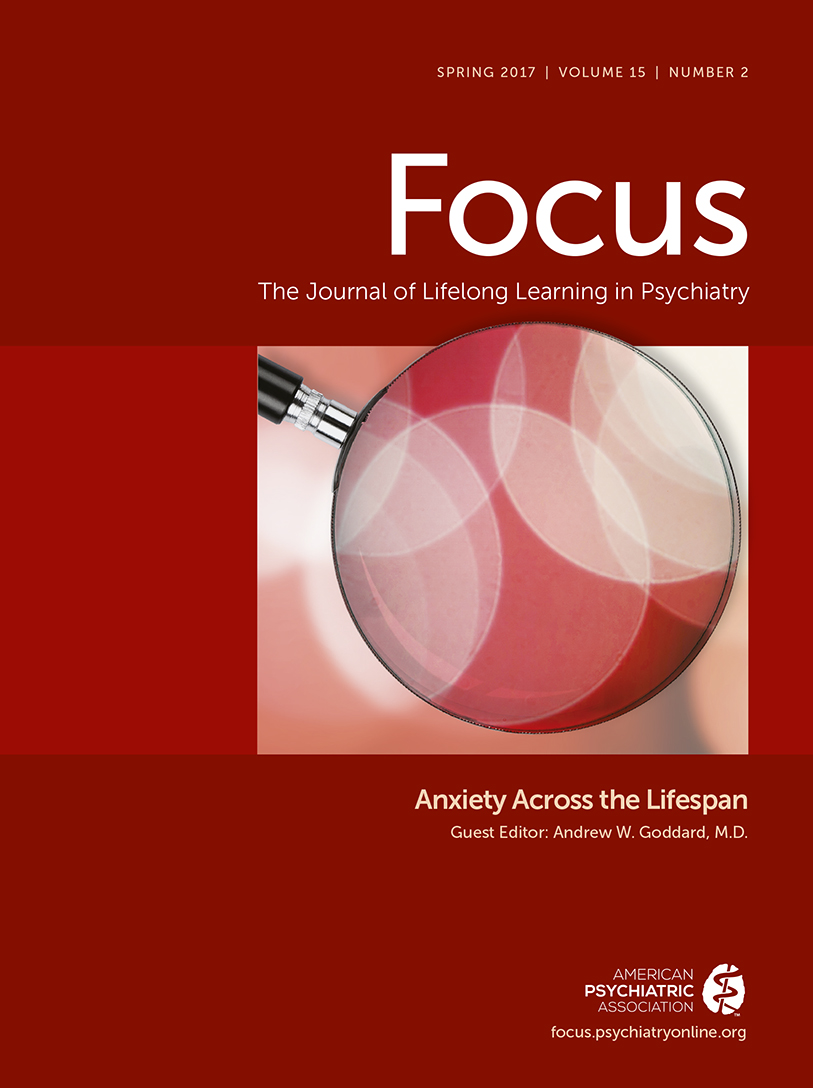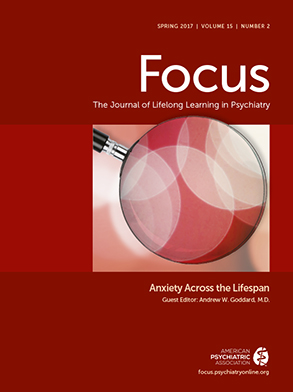Using Neuroscience to Help Understand Fear and Anxiety: A Two-System Framework
LeDoux JE, Pine DS
Am J Psychiatry 2016; 173:1083–1093
Tremendous progress has been made in basic neuroscience in recent decades. One area that has been especially successful is research on how the brain detects and responds to threats. Such studies have demonstrated comparable patterns of brain-behavior relationships underlying threat processing across a range of mammalian species, including humans. This would seem to be an ideal body of information for advancing our understanding of disorders in which altered threat processing is a key factor, namely, fear and anxiety disorders. But research on threat processing has not led to significant improvements in clinical practice. The authors propose that in order to take advantage of this progress for clinical gain, a conceptual reframing is needed. Key to this conceptual change is recognition of a distinction between circuits underlying two classes of responses elicited by threats: 1) behavioral responses and accompanying physiological changes in the brain and body and 2) conscious feeling states reflected in self-reports of fear and anxiety. This distinction leads to a “two systems” view of fear and anxiety. The authors argue that failure to recognize and consistently emphasize this distinction has impeded progress in understanding fear and anxiety disorders and hindered attempts to develop more effective pharmaceutical and psychological treatments. The two-system view suggests a new way forward.
Reprinted with permission from American Psychiatric Association Publishing
Enhancement of Psychosocial Treatment With D-Cycloserine: Models, Moderators, and Future Directions
Otto MW, Kredlow MA, Smits JA, et al.
Biol Psychiatry 2016; 80:274–283
Advances in the understanding of the neurobiology of fear extinction have resulted in the development of d-cycloserine (DCS), a partial glutamatergic N-methyl-d-aspartate agonist, as an augmentation strategy for exposure treatment. We review a decade of research that has focused on the efficacy of DCS for augmenting the mechanisms (e.g. fear extinction) and outcome of exposure treatment across the anxiety disorders. Following a series of small-scale studies offering strong support for this clinical application, more recent larger-scale studies have yielded mixed results, with some showing weak or no effects. We discuss possible explanations for the mixed findings, pointing to both patient and session (i.e. learning experiences) characteristics as possible moderators of efficacy, and offer directions for future research in this area. We also review recent studies that have aimed to extend the work on DCS augmentation of exposure therapy for the anxiety disorders to DCS enhancement of learning-based interventions for addiction, anorexia nervosa, schizophrenia, and depression. Here, we attend to both DCS effects on facilitating therapeutic outcomes and additional therapeutic mechanisms beyond fear extinction (e.g. appetitive extinction, hippocampal-dependent learning).
Reprinted with permission from Elsevier
Clinical Management of Perinatal Anxiety Disorders: A Systematic Review
Marchesi C, Ossola P, Amerio A, et al.
J Affect Disord 2016; 190:543–550
BACKGROUND: In the last few decades, there has been a growing interest in anxiety disorders (AnxD) in the perinatal period. Although AnxD are diagnosed in 4%−39% of pregnant women and in up to 16% of women after delivery, evidence on their clinical management is limited. METHODS: A systematic review was conducted on pharmacological and nonpharmacological treatment of AnxD in the perinatal period. Relevant papers published from January 1st 2015 were identified searching the electronic databases MEDLINE, Embase, PsycINFO and the Cochrane Library. RESULTS: 18 articles met inclusion criteria. Selected studies supported the use of cognitive-behavioral therapy (CBT) for obsessive-compulsive disorder (OCD), panic disorder (PD) and specific phobia both in pregnancy and postpartum. Selective serotonin reuptake inhibitors (SSRIs) led to significant OCD and PD improvement both in pregnancy and postpartum with no side effects for the babies. In the largest clinical sample to date, 65% of postpartum patients who entered the open-label trial of fluvoxamine (up to 300mg/day) experienced a 30% or greater decrease in the total score of the Yale-Brown Obsessive-Compulsive Scale (Y-BOCS). During pregnancy, SSRIs and tricyclic antidepressants (TCAs) led to remission of panic symptoms and healthy outcomes for the babies. LIMITATIONS: Study design, mostly case reports, and enrolment of subjects mainly from outpatient specialty units might have limited community-wide generalisability. CONCLUSIONS: Keeping in mind the scantiness and heterogeneity of the available literature, the best interpretation of the available evidence appears to be that CBT should be the first treatment offered to pregnant and breastfeeding women with AnxD. However SSRIs can represent a first line treatment strategy, and not exclusively in cases where AnxD is refractory to CBT.
Reprinted with permission from Elsevier
Anxiety As a Predictor for Cognitive Decline and Dementia: A Systematic Review and Meta-Analysis
Gulpers B, Ramakers I, Hamel R, et al.
Am J Geriatr Psychiatry 2016; 24:823–842
BACKGROUND: Because anxiety is postulated as a risk factor for dementia, we performed a systematic review and meta-analysis to investigate whether anxiety predicts cognitive decline and/or dementia, taking the stage of cognitive decline as well as setting into account. METHODS: A systematic literature search up to January 2015 was performed to identify all longitudinal studies on the association between anxiety and cognition. Data extraction and methodological quality assessment were conducted independently by two authors. Where possible, pooled relative risks were calculated to examine anxiety as a possible risk factor for cognitive decline cognitive impairment and dementia in community studies (objective 1), as well as for conversion to dementia patients referred to memory clinics (objective 2). RESULTS: Twenty studies met inclusion criteria. Data on cognitive decline were too heterogeneous for meta-analysis. Anxiety predicted incident cognitive impairment (4 studies, relative risk [RR]: 1.77, 95% confidence interval [CI]: 1.38–2.26, z=4.50, p<0.001) and dementia (6 studies, RR: 1.57, 95% CI: 1.02–2.42, z=2.05, p=0.040) in the community, the latter driven by studies with a mean age of 80 years or above. Among clinical mild cognitive impairment samples, anxiety did not predict conversion to dementia (RR: 1.21, 95% CI: 0.90–1.63, z=1.28, p=0.200). CONCLUSIONS: Anxiety is associated with an increased risk for cognitive impairment and dementia in the community. Stronger associations were driven by higher age, suggesting that it is a prodromal symptom. Causal biological pathways have also been described, which could explain the risk for incident cognitive impairment in the community. Future studies should include mediating mechanism when studying anxiety as a predictor for cognitive decline and/or dementia.
Reprinted with permission from Elsevier
Identifying the Women at Risk of Antenatal Anxiety and Depression: A Systematic Review
Biaggi A, Conroy S, Pawlby S, et al.
J Affect Disord 2016; 191:62–77
BACKGROUND: Pregnancy is a time of increased vulnerability for the development of anxiety and depression. This systematic review aims to identify the main risk factors involved in the onset of antenatal anxiety and depression. METHODS: A systematic literature analysis was conducted, using PubMed, PsychINFO, and the Cochrane Library. Original papers were included if they were written in English and published between 1st January 2003 and 31st August 2015, while literature reviews and meta-analyses were consulted regardless of publication date. A final number of 97 papers were selected. RESULTS: The most relevant factors associated with antenatal depression or anxiety were: lack of partner or of social support; history of abuse or of domestic violence; personal history of mental illness; unplanned or unwanted pregnancy; adverse events in life and high perceived stress; present/past pregnancy complications; and pregnancy loss. LIMITATIONS: The review does not include a meta-analysis, which may have added additional information about the differential impact of each risk factor. Moreover, it does not specifically examine factors that may influence different types of anxiety disorders, or the recurrence or persistence of depression or anxiety from pregnancy to the postpartum period. CONCLUSIONS: The results show the complex etiology of antenatal depression and anxiety. The administration of a screening tool to identify women at risk of anxiety and depression during pregnancy should be universal practice in order to promote the long-term wellbeing of mothers and babies, and the knowledge of specific risk factors may help creating such screening tool targeting women at higher risk.
Reprinted with permission from Elsevier
Evidence-Based Pharmacological Treatment of Anxiety Disorders, Post-Traumatic Stress Disorder and Obsessive-Compulsive Disorder: A Revision of the 2005 Guidelines From the British Association for Psychopharmacology
Baldwin DS, Anderson IM, Nutt DJ, et al.
J Psychopharmacol 2014; 28:403–439
This revision of the 2005 British Association for Psychopharmacology guidelines for the evidence-based pharmacological treatment of anxiety disorders provides an update on key steps in diagnosis and clinical management, including recognition, acute treatment, longer-term treatment, combination treatment, and further approaches for patients who have not responded to first-line interventions. A consensus meeting involving international experts in anxiety disorders reviewed the main subject areas and considered the strength of supporting evidence and its clinical implications. The guidelines are based on available evidence, were constructed after extensive feedback from participants, and are presented as recommendations to aid clinical decision-making in primary, secondary and tertiary medical care. They may also serve as a source of information for patients, their carers, and medicines management and formulary committees.
Enhancing Exposure Therapy for Anxiety Disorders, Obsessive-Compulsive Disorder and Post-Traumatic Stress Disorder
McGuire JF, Lewin AB, Storch EA
Expert Rev Neurother 2014; 14:893–910
Translating findings from basic science, several compounds have been identified that may enhance therapeutic outcomes and/or expedite treatment gains when administered alongside exposure-based treatments. Four of these compounds (referred to as cognitive enhancers) have been evaluated in the context of randomized controlled trials for anxiety disorders (e.g. specific phobias, panic disorder, social anxiety disorder), obsessive-compulsive disorder and posttraumatic stress disorder. These cognitive enhancers include d-cycloserine, yohimbine hydrochloride, glucocorticoids and cortisol and brain-derived neurotrophic factor. There is consistent evidence that cognitive enhancers can enhance therapeutic outcomes and/or expedite treatment gains across anxiety disorders, obsessive-compulsive disorder and posttraumatic stress disorder. Emerging evidence has highlighted the importance of within-session fear habituation and between-session fear learning, which can either enhance fear extinction or reconsolidate of fear responses. Although findings from these trials are promising, there are several considerations that warrant further evaluation prior to widespread use of cognitive enhancers in exposure-based treatments. Consistent trial design and large sample sizes are important in future studies of cognitive enhancers.
Reprinted with permission from Taylor and Francis. Full article available at
tandfonline.com.
24- and 36-Week Outcomes for the Child/Adolescent Anxiety Multimodal Study (CAMS)
Piacentini J, Bennett S, Compton SN, et al.
J Am Acad Child Adolesc Psychiatry 2014; 53:297–310
OBJECTIVE: We report active treatment group differences on response and remission rates and changes in anxiety severity at weeks 24 and 36 for the Child/Adolescent Anxiety Multimodal Study (CAMS). METHOD: CAMS youth (N=488; 74% ≤ 12 years of age) with DSM-IV separation, generalized, or social anxiety disorder were randomized to 12 weeks of cognitive-behavioral therapy (CBT), sertraline (SRT), CBT+SRT (COMB), or medication management/pill placebo (PBO). Responders attended 6 monthly booster sessions in their assigned treatment arm; youth in COMB and SRT continued on their medication throughout this period. Efficacy of COMB, SRT, and CBT (N=412) was assessed at 24 and 36 weeks postrandomization. Youth randomized to PBO (N=76) were offered active CAMS treatment if nonresponsive at week 12 or over follow-up and were not included here. Independent evaluators blind to study condition assessed anxiety severity, functioning, and treatment response. Concomitant treatments were allowed but monitored over follow-up. RESULTS: The majority (>80%) of acute responders maintained positive response at both weeks 24 and 36. Consistent with acute outcomes, COMB maintained advantage over CBT and SRT, which did not differ, on dimensional outcomes; the 3 treatments did not differ on most categorical outcomes over follow-up. Compared with COMB and CBT, youth in SRT obtained more concomitant psychosocial treatments, whereas those in SRT and CBT obtained more concomitant combined (medication plus psychosocial) treatment. CONCLUSIONS: COMB maintained advantage over CBT and SRT on some measures over follow-up, whereas the 2 monotherapies remained indistinguishable. The observed convergence of COMB and monotherapy may be related to greater use of concomitant treatment during follow-up among youth receiving the monotherapies, although other explanations are possible. Although outcomes were variable, most CAMS-treated youth experienced sustained treatment benefit. Clinical trial registration information-Child and Adolescent Anxiety Disorders (CAMS); URL:
http://clinicaltrials.gov. Unique identifier: NCT00052078.

